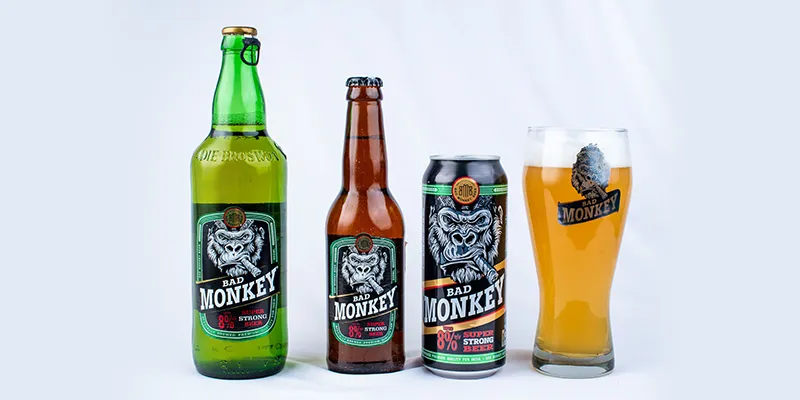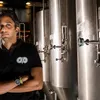This Made-in-India beer brand brewed Rs 130 Cr turnover in just two years
Founded in 2018 by Rohan Khare, Bad Monkey Beer has sold over nine lakh cases of beer across four states in India. It also exports to Australia.
Rohan Khare has always been passionate about beverages, particularly beer. So it was not surprising when he decided to set his heart to it and pursue a course at the Wine and Spirit Education Trust (WSET) right after completing his graduation from Delhi University. He even worked with liquor brand Rock and Storm for three years as the Product Head.
Right through his journey, Rohan believed that a strong beer brand in the market that had consistency and taste was missing. According to a report by Businesswire, estimates revealed that Indians prefer strong (lager) beer (with alcohol content more than five percent) followed by wheat beer, Stout & Porters, Ale, Sahiti, and others.
With around 140 brands already in the beer segment including United Breweries, Budweiser, Carlsberg, , etc, Rohan decided to dive into this market when he launched Delhi-based in July 2018.
Brewing the beer
While the name might sound unusual, it’s interesting how the team coined ‘Bad Monkey Beer.’ Rohan says that in the early days of the company in 2018, outside his Delhi office, there were several monkeys who used to cause menace. One day, a person vexed with their behaviour blurted out “Bad Monkey!” This resonated with Rohan and stayed with him, and that’s how the name came into existence.
The beer is brewed in batches in its manufacturing unit in Punjab. The raw materials are majorly imported — while the malted barley comes from Europe, the hops come from North America (particularly the US). The water coming from the Himalayas is also used in the brewing process.
The company counts consistency and quality as its USP. Rohan refuses to divulge details about how they achieve that but adds that the company has a team of qualified brewers. Furthermore, every batch produced is tested in the company’s in-house laboratory and internal systems ensure that the same texture is replicated across all batches.
The beer is available in a 650 ml bottle, 500 ml can, and is also served in 330 ml pints. In Delhi, the bottle is priced at Rs 135 and the can is priced at Rs 100. So far, the company has sold over 9 lakh cases of beer.
Overcoming challenges in the Indian beer landscape
Manufacturing and trading beer in the Indian market is not a simple endeavour. Rohan says that this is the single-biggest challenge he has faced as a ‘beerpreneur’. The market is mostly regulated and governed by the state governments to have better control over the consumption and pricing patterns. This leads to an increase in liquor taxes, especially excise duties.
Rohan says that “selling beer in India is the same as selling it in 29 different countries.” He explains, “Every state has its own excise duties, policies, and import-export rules which are different from other states. Sometimes, these states even want different packing materials for their state, which makes it challenging for us.”
Rohan says that overcoming this was initially difficult as the “volumes were low” but what kept them going was the faith of their channel partners.
He says they would organise tasting sessions for their channel partners, retailers etc. The creases started to be ironed out when positive feedback poured in and the product gained acceptance.
Bad Monkey Beer started its journey by selling in Delhi and Uttar Pradesh. Today, it also sells in Chhattisgarh and Uttarakhand, and even exports to Australia. Rohan says that the advantage of selling beyond India lies in the fact that the market is much “more matured” and “regulations are not as complicated as in India”.
The company clocked Rs 130 crore in just two years.

Decoding the business strategies
To sell liquor in India, one has to be creative. The Indian government’s blanket ban on the direct advertising of liquor and tobacco on mainstream media has ruffled some feathers and forced the industry stakeholders to find other avenues.
Remember when Kingfisher beer, Vijay Mallya-led beer brand, was positioned as a lifestyle brand to grab eyeballs of the Indian market? The Kingfisher models, calendar and especially the aviation vertical created an uproar in the country. However, the digital boom has given liquor brands some space to override such advertorial challenges. In 2015, the UB Group also partnered with digital media platform, The Viral Fever (TVF) to leverage from India’s digital marketing wave.
Rohan says that though the advertising of alcohol is restricted, social media platforms are the best places because people in advanced age brackets such as 40-60 years are also on these platforms.
He says, “Online platforms have given us a way to directly connect with our customers.” Before COVID-19 struck, the business would also set up stalls and run campaigns at live concerts, food events, etc.
The impact of COVID-19 and what the future holds
The coronavirus pandemic hit the world like a tsunami. It brought the entire business ecosystem to a standstill, with a freeze in production and disruption in supply chains that went on for months.
Rohan says they were able to navigate through the crisis as they always plan in advance. “We had enough raw materials stocked up to last for three-four months. However, we did take a hit of losses worth 10-15 percent.”
Rohan adds that in some states such as Punjab, West Bengal, Odisha, and Jharkhand, the government allowed some relaxations and even started online delivery of liquor but the response was dull.
The report by Businesswire also states that the per capita beer consumption in India is very low as compared to other Asian-Pacific countries. He says that beer consumption further saw a drop of 60-65 percent as people stopped drinking cold beverages in the wake of the pandemic. He says that it will take a year more for the industry to recover.
Going forward, Rohan plans to launch the brand in Telangana next year and is also planning to deeper penetrate into the “less-regulated global markets.” Bad Monkey will enter a few markets in Africa next year.
Edited by Kanishk Singh




![[Startup Bharat] How these entrepreneurs left their cushiony lives in the US to craft a successful Indian beer brand](https://images.yourstory.com/cs/2/3fb20ae02dc911e9af58c17e6cc3d915/SBH-2-1606220506088.png?fm=png&auto=format&h=100&w=100&crop=entropy&fit=crop)





